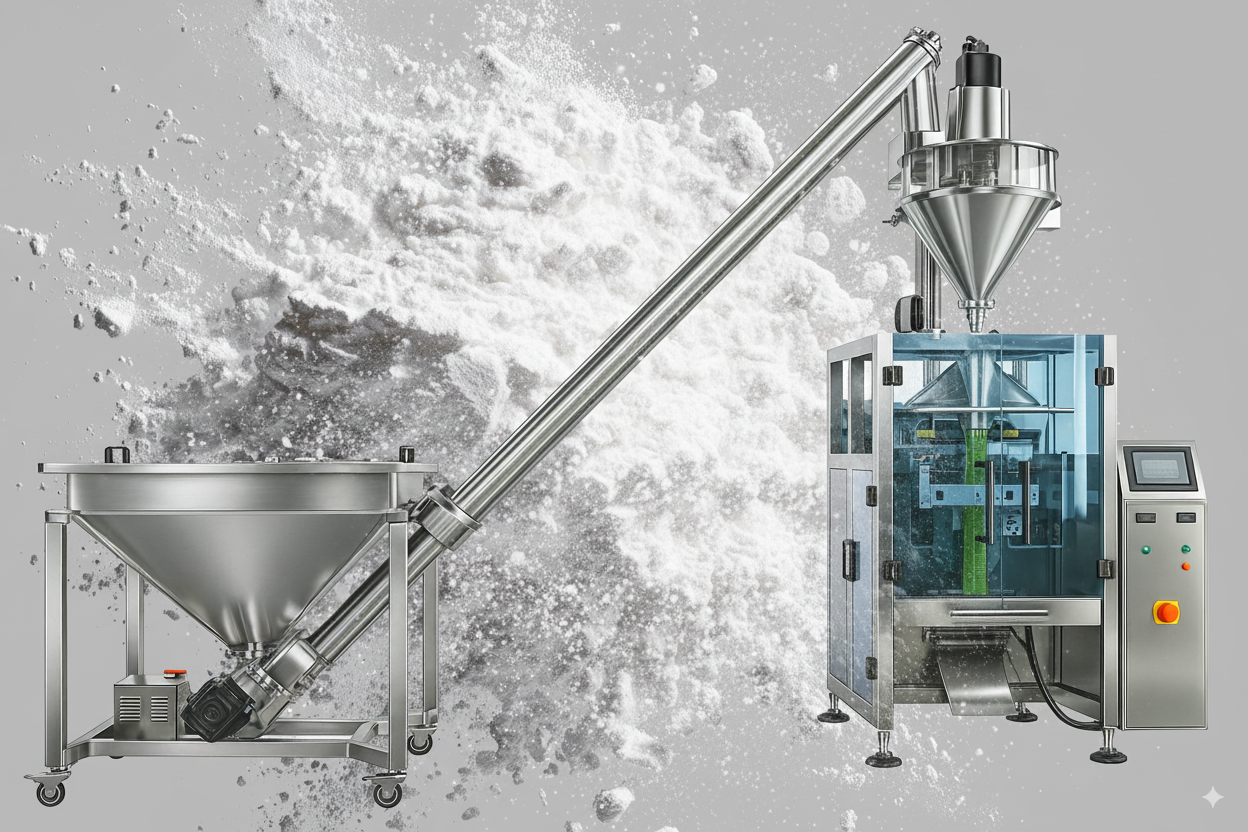Introduction
Powder products hold crucial positions across multiple industries. For instance, food, pharmaceuticals, chemicals, and construction materials rely heavily on powders. Moreover, packaging quality directly affects product performance. From milk powder to pharmaceutical compounds, proper packaging ensures safety and effectiveness.
However, powder packaging presents unique technical challenges. First, flowability varies significantly between products. Second, dust generation creates environmental concerns. Third, precision requirements demand advanced technology. Fortunately, Vertical Form Fill Seal (VFFS) packaging machines offer comprehensive solutions.
VFFS machines excel due to their exceptional adaptability. Moreover, their automation capabilities suit powder applications perfectly. This article explores VFFS applications in powder packaging thoroughly. Additionally, it provides optimization guidance for your processes.
Unique Challenges in Powder Product Packaging
Powder packaging faces several distinct challenges. First, dust issues affect working environments. Second, flowability variations complicate handling. Third, accuracy requirements demand precision equipment.
•Dust Issues: Fine powders generate dust during filling processes. Consequently, working environments become contaminated. Moreover, product loss occurs frequently. Additionally, cross-contamination risks increase significantly.
•Flowability Variations: Different powders exhibit vastly different flow characteristics. For example, free-flowing granules behave differently than cohesive fine powders. Therefore, feeding mechanisms must adapt accordingly.
•Accuracy Requirements: Both pharmaceuticals and food products demand strict weight accuracy. Moreover, compliance depends on precise filling. Furthermore, consumer satisfaction requires consistency.
•Hygiene and Safety: Food and pharmaceutical powders need strict hygiene standards. Additionally, contamination prevention becomes essential. Moreover, regulatory compliance must be maintained.
•Package Integrity: Powder products are susceptible to moisture and oxidation. Therefore, excellent sealing properties become necessary. Furthermore, extended shelf life depends on package quality.
Advantages of VFFS Machines in Powder Product Packaging
VFFS packaging machines provide multiple advantages through their unique design. Moreover, their configurability suits diverse powder applications effectively.
1.Efficient Automation: VFFS machines complete entire packaging processes automatically. First, they unwind film materials. Next, they form bags precisely. Then, they fill powders accurately. Finally, they seal and cut packages.
2.Precise Filling: Auger Fillers enable accurate powder measurement. Moreover, rotating auger screws transport powder reliably. Additionally, precise control ensures weight accuracy. Furthermore, density variations are accommodated effectively.
3.Dust Control: Auger fillers typically employ enclosed designs. Moreover, dust collection systems integrate easily. Consequently, dust generation is controlled effectively. Additionally, working environments improve significantly.
4.Excellent Sealing: Heat sealing technology creates strong, sealed packages. Moreover, moisture and oxidation protection are provided. Furthermore, product shelf life extends considerably.
5.Versatility: Multiple bag types accommodate different market requirements. For instance, pillow bags suit basic applications. Meanwhile, Gusset bags provide standing capability. Additionally, quad seal bags offer a premium presentation.
6.Hygienic Design: Stainless steel construction meets industry standards. Moreover, cleaning and maintenance become simplified. Furthermore, food and pharmaceutical requirements are satisfied.
Key Components and Technologies of VFFS Powder Packaging Machines
Auger fillers serve as core filling components in powder VFFS machines. Moreover, they achieve volumetric or weight measurement through precise control. Specifically, auger speed and rotation count determine fill accuracy.
For powders with poor flowability, agitating auger fillers work effectively. Additionally, they ensure uniform material discharge. Furthermore, they prevent bridging and ratholing.
2. Film Handling System
Powder packaging typically requires composite films with excellent barrier properties. Moreover, film handling systems ensure consistent performance. Specifically, dancer rollers and edge control systems maintain proper tension [1].
Constant tension prevents film deformation during forming. Additionally, it ensures consistent bag appearance. Furthermore, sealing quality remains uniform throughout production.
3. Sealing Technology
PID temperature-controlled heat sealing systems ensure precise temperature control. Moreover, consistent sealing results from accurate temperature management. Additionally, strong seals protect product integrity.
For oxygen and moisture-sensitive powders, inert gas filling provides additional protection. Furthermore, nitrogen filling extends shelf life significantly. Additionally, product quality is maintained longer.
4. Dust Control Systems
Integrated dust collection devices address powder dust issues effectively. Moreover, negative pressure in filling areas removes airborne particles. Consequently, working environments remain clean. Additionally, product loss is minimized.
How to Optimize Your Powder Packaging Process
Several strategies can optimize powder packaging performance. First, analyze product characteristics thoroughly. Next, select appropriate materials carefully. Then, maintain equipment properly. Finally, train operators adequately.
1.Precise Product Characteristic Analysis: Detailed analysis guides equipment selection effectively. For instance, bulk density affects auger sizing. Moreover, flowability determines feeding system requirements. Additionally, particle size influences dust control needs.
2.Choose Appropriate Film Materials: Barrier properties must match product requirements. Furthermore, shelf life expectations guide material selection. Additionally, storage conditions influence film choice.
3.Regular Maintenance and Cleaning: Powder packaging machines require thorough cleaning regularly. Moreover, residue buildup must be prevented. Furthermore, equipment performance depends on proper maintenance.
4.Operator Training: Adequate training ensures optimal performance. Moreover, operators must understand machine operation thoroughly. Additionally, troubleshooting skills reduce downtime.
5.Consider Automation Integration: Upstream and downstream equipment integration creates fully automated lines. Furthermore, overall efficiency improves significantly [2]. Additionally, labor requirements decrease substantially.
Conclusion
VFFS packaging machines represent ideal solutions for powder product packaging. Moreover, they address unique powder challenges effectively. Through innovative technology, they provide efficient, precise, and hygienic packaging.
Understanding VFFS principles and optimization strategies enables significant improvements. Furthermore, packaging quality and production efficiency increase substantially. Ultimately, companies can excel in competitive markets through proper implementation.


